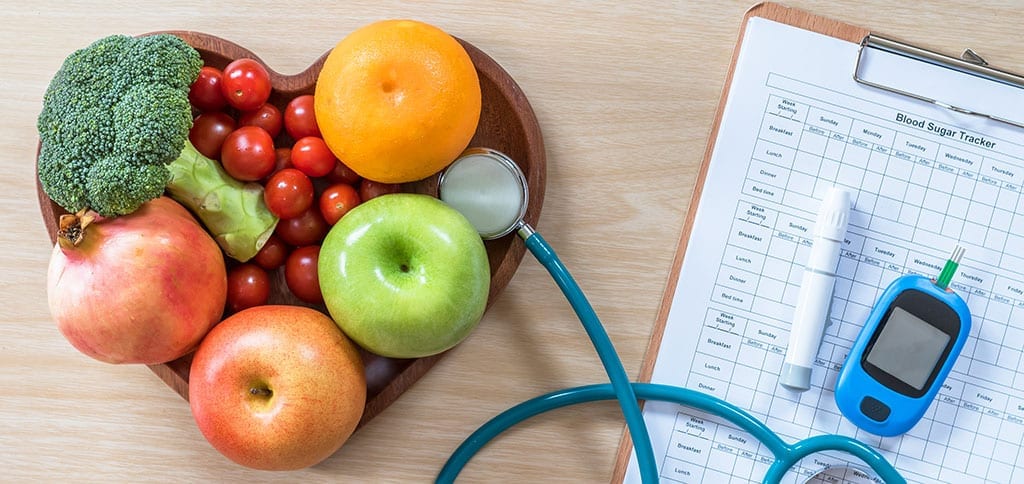Knowing the basics about diabetes helps identify what puts people at risk for developing the disease. Some people are living with diabetes and don’t even know it. According to the CDC, who just released the 2017 Diabetes Statistics Report, “30.3 million or 9.4% of the population in the US have diabetes. Of those 30.3 million, 23.1 were diagnosed and 7.2 million were still undiagnosed. 84.1 million Americans over 18 have pre-diabetes. Those with pre-diabetes have a high prevalence of developing cardiovascular disease and moving on to full diabetes. The people with the highest incidence remains those over 65 years of age at a level of 23.1 million. Diabetes remains the 7th leading cause of death in the US.” You need to recognize the signs and symptoms to make lifestyle changes and get treatment when diabetes is diagnosed before it gets worse and leads to an array of complications.
How is Diabetes Diagnosed?
While 50 percent of people experience typical diabetes symptoms, others experience nothing. Often, they find out they have diabetes at a health fair screening, a random blood sugar reading or a routine medical office exam from their primary physician, internist, dentist or eye doctor. Early detection is critical. There are 3 primary tests used to diagnose diabetes. The simplest one is a fasting blood sugar or FBG, drawn is the physician’s office or at a lab. You should be fasting until the blood is drawn. A normal value for FBG is between 60-99 mg/dl. If the value is between 100-125mg/dl, it is considered pre-diabetes. A value of 126mg/dl or higher, on 2 separate blood tests, is a confirmed diagnosis of diabetes. The second test which can find a diagnosis of diabetes is called an A1C. It is also a blood test, which does not require fasting since it indicates your average blood sugars over a 2-3-month period. An A1C shows how much sugar is attached to your red blood cells. A normal A1C value is 4.5-5.6%. A pre-diabetes A1C value is 5.7-6.4%. Once an A1C reaches 6.5%, a diabetes diagnosis is made. The third test which is used less frequently since it requires more time is the oral glucose tolerance test or OGTT. You arrive at the lab or physician’s office after fasting since midnight and have a fasting blood sugar drawn. You then drink 75 grams of a sweet, syrupy drink of carbohydrate solution. After relaxing, your blood is then re-drawn after 2 hours and the results are reported. A blood sugar value of 139mg/dl or less is considered normal. A blood sugar value of 140-199mg/dl is considered pre-diabetes and a reading of 200mg/dl or higher is considered diabetes. This test is most frequently used to diagnose gestational diabetes or diabetes during pregnancy, but it can be used if there is a question concerning the other blood test results.
What are the Possible Signs and Symptoms of Diabetes?
- Blurred vision is a symptom of diabetes. Raised blood sugar levels take fluids from body tissues, including the lenses of the eyes which may have difficulty focusing. As blood sugar is controlled, the vision will improve. Do not change your eye glass prescription until blood sugars are controlled for at least 8 weeks.
- Intense hunger is another symptom. Fluctuating blood sugar, unstable insulin levels and abnormal hormones can cause an excessive feeling of hunger. The cells are not getting fed. People often crave foods they should limit such as simple carbohydrates, fruit juices and soda. Eating a full meal and continuing to be hungry is a common diabetes symptom.
- Extreme fatigue and weakness are signs of diabetes. They are caused by dehydration and the body’s inability to use sugar for energy needs and function properly.
- Chronic infections and skin infections that do not heal are a symptom of diabetes. High levels of blood sugar may impact the body’s natural ability to fight infections. White blood cells can’t function properly and are not working as hard to fight off the existing infection.
- More frequent and reoccurring infections are very common. They often strike the skin, gums and bladder. Women may experience urinary tract infections (UTIs) and vaginal infections. Diabetes impacts small blood vessels and nerves, leading to a decrease in blood supply and impairing the ability to heal.
- Excessive thirst may be a sign of diabetes. Fluids are drawn from tissues, making you dehydrated. Generally, sweet beverages are craved leading to the cycle of higher blood sugars and increased urination since the body is trying to remove the excess sugar.
- Weight loss is a symptom of Type 1 diabetes. The loss of sugar through frequent urination causes a loss of calories. Diabetes can also keep sugar from reaching the cells, causing ongoing hunger. In combination, the result is rapid weight loss.
- You may experience sexual problems including erectile dysfunction and lowered sexual desire and function. Often this is a result of nerve problems or hormonal fluctuations from irregular blood sugars. For men, this problem can be addressed with an erection pump.
- You may experience tingling, burning and numbness in your fingers or feet which is an indication of nerve problems in the extremities.
Who Gets Diabetes More Frequently?
There is a higher percentage of diabetes seen in those who are American/Indian, and Alaskan Natives. More African Americans and Hispanics get diabetes. People in the southern states get diabetes more frequently. Excessive cases of diabetes reach up both coasts through the Mid-Atlantic states and up through California and Oregon. This could be due to genetics, environmental, dietary or other lifestyle reasons.
Does Diabetes Have a Genetic Component?
Both types of diabetes type 1 and type 2 have genetic components. Although genes are not the only cause, they do play a significant part. Triggers seen in development of type 1, which is considered an autoimmune disease are living in colder climates and more diagnoses occur during the winter. Type 1 may be due to exposure to viruses. Type 1 diabetes is seen less frequently when you have been breast feed. Type 2 is even more common in families due to hereditary, along with lifestyle and environmental components.
What are Possible Complications of Diabetes if Not Treated?
Cardiovascular disease is the leading cause of death when you have diabetes. Your risk of heart attack, stroke, open heart surgery, atrial fibrillation and heart failure increase if diabetes is not controlled. Peripheral vascular disease is also seen when diabetes remains uncontrolled. Nerve endings are affected by the excess sugar which eventually damages the function. Nerve endings can be affected in the legs and feet and hands. Gastroparesis is a digestive problem which slows gastric emptying due to damaged nerves in the stomach. Retinopathy or nerve ending problems in the eyes due to elevated blood sugars can lead to blindness, if not treated. Nephropathy or kidney disease can result in need for dialysis, if diabetes is not well managed. Diabetic foot disease is the leading risk for amputation if blood sugar numbers stay high. Gum disease and bleeding in the gums is elevated due to excess sugar in the mouth from uncontrolled diabetes. Diabetes, which is not well controlled can affect almost all parts of your body. Early detection and treatment can help you avoid these dangerous complications.
What Can I Do to Help Control My Diabetes and Avoid Problems?
Healthy lifestyle habits help prevent diabetes or minimize its symptoms. Start by seeing your physician, whether it be a primary care, internist or endocrinologist which is a MD who specializes in the treatment of diabetes. They will generally want to see you every 3 months for blood work and an exam. Make and keep all your appointments. Make sure your blood pressure is controlled-130-140/80 mm/hg and that your LDL (bad cholesterol) is 70 mg/dl or less, HDL (good cholesterol) is at least 50mg/dl. Reduce saturated fats and include aerobic exercise. If lifestyle changes do not work, talk to your doctor and consider taking medications.
Find a diabetes education/management program, which is generally covered by your health insurance. You are entitled to 10 hours of training/education a year. You will learn that this is a self-managed disease and that you can do a lot to help control your diabetes.
If you are placed on diabetes medication, make sure you know when and how much to take. Keep a list in your wallet of all medications, doses and what the medications do. Never run out of your medication by either using automatic refills or reordering when you are down to a week’s worth of medication remaining. Order and learn to use a glucose meter. Keep track of your blood sugar patterns by testing regularly. Talk to your doctor about when to test and what numbers to look for because testing with no purpose gives you little information about how to better manage your diabetes. If you have type 1 diabetes or type 2 diabetes, which is difficult to control, consider a CGM (continuous glucose monitor) and an insulin pump, for more accuracy.
Schedule an eye exam at least annually with an ophthalmologist or optometrist to check for cataracts, macular degeneration and especially for retinal disease. See your dentist at least 2 times a year for a deep cleaning to help prevent gum disease. Chew sugar-free gum with Xylitol between meals to help reduce plaque formation. Brush and floss daily and include the use of a water-pik for extra deep cleaning and removal of plaque. See a foot doctor or podiatrist for a yearly check or more often if you have thick, yellow, split nails (fungus) which makes them difficult to trim properly. Understand that this disease is all about lifestyle changes in 90-95% of cases.
Begin an exercise program after checking with your MD and start by walking 10-15 minutes daily. Add more time as you get comfortable and try to work up to 20-30 minutes twice daily especially 20-30 minutes after your largest meal. Exercise uses sugar for energy which you just got from eating your food. Join dance or Zumba classes, if you prefer a group setting and add balance, stretching and strength training (to add muscle mass) to your program.

Drink alcohol in moderation if you already drink but understand alcohol may cause other problems including certain types of cancer. A female and male over 65 can drink one drink daily and a male under 65 can drink two drinks. A drink is counted as 1.5 ounce of hard liquor, 4 ounces of wine or 12 ounces of beer. Do not add sweet mixers such as pineapple or orange juice, coke, ginger ale or even tonic water which is full of sugar, so mix alcohol with club soda or regular water.
Eat on time and do not skip meals. Do not go longer than 4-5 hours between meals. Try to maintain a healthy weight. Losing 5-7% of your body weight when overweight has been proven to lower blood sugars. Quit smoking if you smoke and reduce stress as it can raise blood sugars. Learn to meditate, practice deep breathing or take a Tai Chi class. If stress remains a concern, consider talking to a social worker or therapist. Join a support group.
Pay attention to body hints to recognize the symptoms of diabetes. If you experience any of these symptoms, visit a doctor to get a diagnosis and then learn what you need to do. Diabetes can be well managed, so you can avoid complications!
Have a question or comment? Then post below, no registration required. I would love to hear from you!
NOTE: Consult your Doctor first to make sure my recommendations fit your special health needs.







Help me I am in Type – I problem (Diabetes)